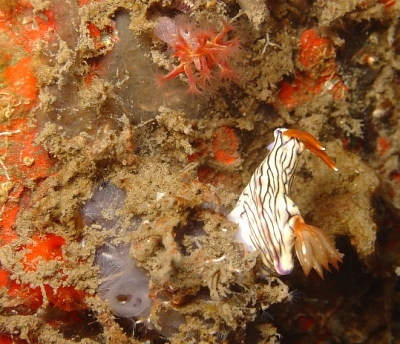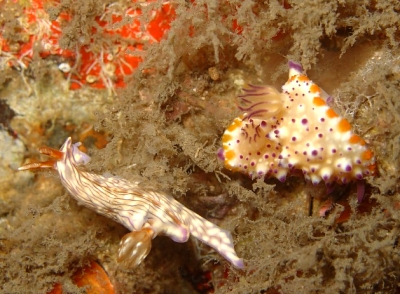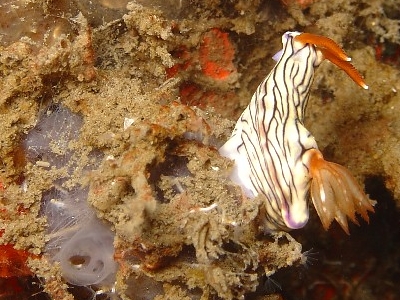Re: Hypselodoris zephyra feeding
September 4, 2008
From: Barbara Hanchard


Concerning message #21848:
Dear Bill,
Yes I was fairly certain that was an egg ribbon....just my very warped sense of humour there. Tamara and I are still living off the nudi toilet humour generated by my mistake. I won't blame Tamara for this as she is fairly new to the nudibranch obsession.
Anyway, thank you for your detailed response it was most helpful. I went back to look at other photos to see if I had one that showed a fibrous skeleton or a clearer reticulate pattern of fibers of what you think might be a dysideid sponge and the attached photo might be slightly better definition. A portion of the sponge to the left of the Hypselodoris zephyra is raised in a cone shape. I think I mentioned earlier that at the time these photos were taken the wreck had only been underwater for 4 months which would perhaps explain why the colony was too thin 'to study the layers and arrangement of the fibre bundles' as they were probably in the early stages of growth.
Locality: Tommy Chan Wreck, Ranadi, 35 meters, Solomon Islands, Pacific Ocean, 12 January 2006, Wreck. Length: 30mm. Photographer: N.Barbara Hanchard.
I know we are not suppose to throw other species into the mix but I thought I would also show you another of the chromodrorid also found in numbers along side the H. zephyra. Particularly, as there also seems to be some feeding information on the Forum for Mexichromis multituberculata (specifically Mike Krampf's message #20416 ).
Barbara
barbara.hanchard@ffa.int
Hanchard, N.B., 2008 (Sep 4) Re: Hypselodoris zephyra feeding. [Message in] Sea Slug Forum. Australian Museum, Sydney. Available from http://www.seaslugforum.net/find/21863
Dear Barbara,
Thanks for persisting with the sponge mystery. As I mentioned in Mike Krampf's message, I welcome 'multi-species' messages like this where the fact that the species are together is the point of the message. Mexichromis multituberculata is proving to be an excellent 'indicator' species because it seems to feed only on species of the dysideid genus Euryspongia and it is often found with other chromodorid species. In Mike Krampf's message it is with two other species, and in Ken Tucker's message [#20161] it is with one other. I think we can be pretty sure that if we find Mexichromis multituberculata and other chromodorids feeding together, then their food will be Euryspongia, or at least a dysideid.
From this and your earlier messages, I looks like Hypselodoris zephyra and H. krakatoa both feed on a species of Euryspongia.
Best wishes,
Bill Rudman
Related messages
-
Re: Hypselodoris zephyra feeding
From: N. Barbara Hanchard, September 2, 2008 -
Re: Hypselodoris zephyra feeding
From: Philip Cromwell, November 23, 2007 -
Hypselodoris zephyra feeding
From: Erwin Kodiat, November 14, 2007 -
Re: Hypselodoris zephyra - feeding observations
From: David Mullins, November 13, 2007 -
Hypselodoris zephyra - feeding observations
From: Bruce Wilkie, April 2, 2007 -
Hypselodoris zephyra? from North Sulawesi
From: Jack Connick, May 29, 2006 -
Hypselodoris zephyra feeding
From: Erwin Kodiat, December 19, 2005 -
Hypselodoris zephyra on the Sunshine Coast
From: Gary Cobb, December 3, 2003 -
Re: Hypselodoris nigrostriata from Bali
From: Phil Cromwell, March 21, 2003 -
Hypselodoris zephyra off North Queensland
From: Mikkel Mowinckel, March 21, 2003 -
Hypselodoris zephyra from northern New South Wales (1)
From: Bill Rudman, March 21, 2003 -
Hypselodoris zephyra from northern New South Wales (2)
From: Bill Rudman, March 21, 2003 -
Hypselodoris zephyra from Vanuatu
From: Vinka Stenhouse, February 14, 2003 -
Hypselodoris zephyra from Indonesia
From: Alice Lee, January 22, 2003 -
Hypselodoris zephyra from South Japan
From: Mizuho, January 24, 2001 -
Hypselodoris zephyra from Vanuatu
From: Vinka Stenhouse, March 22, 2000
